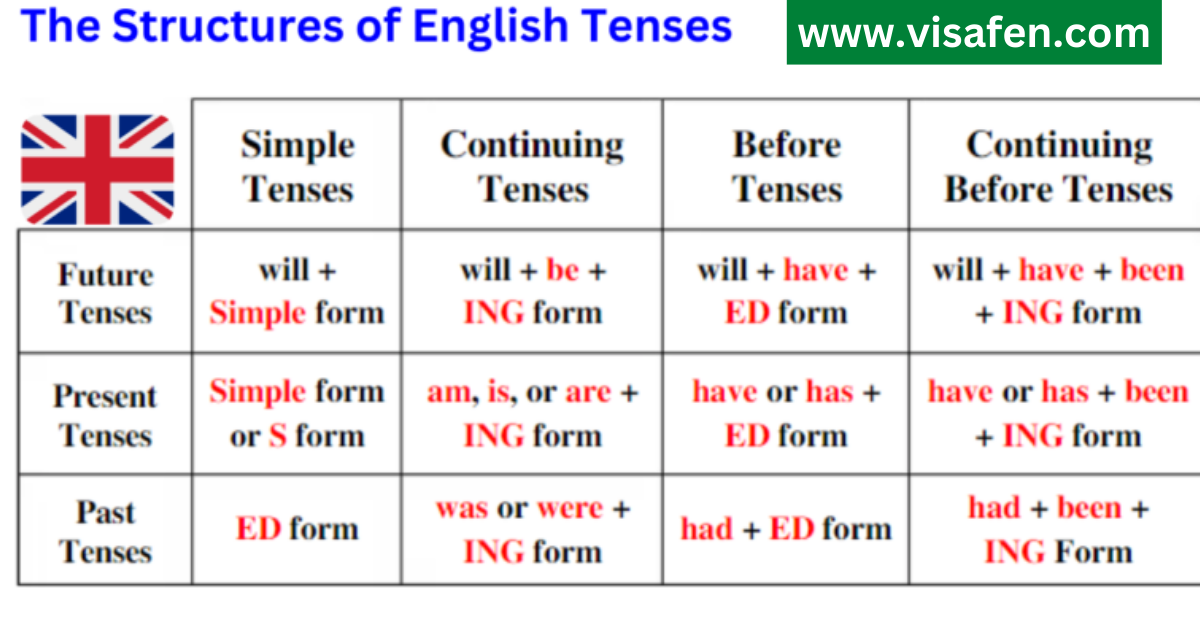Present Continuous Tense
The English Tense System
The links below are to lessons for each of the 12 basic tenses.
In each lesson we look at two aspects of the tense:
-
- Structure: How do we make the tense?
-
- Use: When and why do we use the tense?
Some lessons look at additional aspects, and most of them finish with a quiz to check your understanding.
Present Continuous Tense
Present Perfect Continuous Tense
Future Perfect Continuous Tense
Tenses
We use different tenses to describe the time that the verb refers to.



Present continuous tense
also known as the present progressive, is most often used to talk about actions that are happening right now, temporary situations, and annoying habits. Like the simple present, it can also be used to talk about definite future plans.
It is formed by using the present tense of “to be” (am/are/is) and the present participle (ending in “-ing”) of a verb.
| Subject | Simple present tense of “to be” | Present Participle |
| I | am | cooking. |
| you/you all/we/they | are | cooking |
| he/she/it/Anthony | is | cooking. |
Note: Stative Verbs
Some verbs, called “stative” or “non-continuous” verbs, can’t be used in continuous tenses. Others can be used in continuous tenses, but their meaning changes. Make sure you understand the difference between stative and non-stative verbs while using present continuous and all continuous tenses. You can find more information here.
When to use the Present Continuous Tense
Temporary Actions Happening Now
When an activity is happening at the time of speaking, use the present continuous tense.
- Margaret is sleeping now.
- People are beginning to take their seats for the performance.
- You are wearing my gloves.
In English, “now” can refer to “right at this moment,” “today,” “this week,” and even “this year.” We can also use the present continuous tense to talk about actions of a longer duration that we aren’t necessarily doing at the moment of speaking.
- Dr. Johnson is teaching at the University of Kansas this year.
- I’m reading an interesting book about space exploration.
- Andrew is taking two math classes this semester.
The present continuous emphasizes the temporariness of an action. When you want to stress that something is not going to last long, use the present continuous. Use the simple present for ongoing actions or states that are more permanent.
- I am living in London this year. (Temporary; present continuous)
- I live in London. (More permanent; simple present)
- Abby is working as a waiter until she finds a job in technology. (Temporary)
- Jacob works as a programmer for Google. (More permanent)
Definite Future Plans
Like the simple present tense, you can use the present continuous to talk about things that are almost certain to happen.
- Elaine is meeting her mom for lunch tomorrow.
- Next year, I’m finding a quieter place to live.
- Are you leaving town tomorrow?
Annoying Habits
Normally, we use the simple present to talk about habits, or things that happen all the time. However, if you want to emphasize that we don’t like the action, use the present continuous tense with a frequency expression (always, constantly, continually, all the time)
- Jessica is always complaining about her job.
- You are constantly losing your glasses.
- Bunnies are continually destroying my herb garden!
New or Temporary Habits
You can also use the present continuous to describe new or temporary habits. In this case, it doesn’t mean the actions are annoying. To make your meaning clear, it can help to add a word that emphasizes that the action is new or temporary, like “now” or “recently.’
- You’re eating too much fast food these days.
- She is jogging every morning now.
- The newlyweds are calling each other “Snugglebear” and “Pookie.”
Slowly Changing Situations
When we talk about gradually changing situations, or developing states, we also use the present continuous tense.
- The earth is becoming warmer because of the greenhouse effect.
- You’re getting better at playing the drums.
- The gap between the rich and poor is widening.
- Your grades are improving.
Negative Statements
To make the negative with the present continuous tense, just put “not” between the “to be” verb and the present participle:
- I am not going to New York with you today.
- She is not feeling well today.
- The athletes are not running in this race.
Question Forms
Information Questions about the Subject
To make a question about the subject of a sentence, use a question word as the subject. the form is: question word + “to be” + main verb (ing) + rest of sentence:
- ??? is playing chess. –>
- Who is playing chess?
- ??? people are coming to the party. –>
- How many people are coming to the party?
- ???’s mom is making cupcakes. –>
- Whose mom is making cupcakes?
Questions about the Verb or Words after the Verb
To make a yes/no question about the verb or words after the verb with the present continuous tense, put the “to be” verb before the subject:
- Are you eating ice cream?
- Are we traveling to Mexico?
- Is she coming to dinner?
To make an open question about the verb or words after the verb with the present continuous tense, put the verb before the subject, and a question word (who, what, where, when, why, how) before the verb:
- Why are you eating ice cream before dinner?
- When are we traveling to Mexico?
- What is she wearing to dinner?